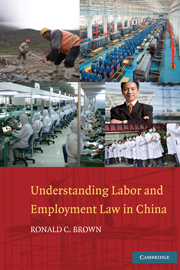Book contents
- Frontmatter
- Contents
- Preface
- Acknowledgments
- Understanding Labor and Employment Law in China
- PART I UNDERSTANDING CHINA'S REGULATION OF THE WORKPLACE
- PART II EMPLOYMENT RELATIONSHIPS
- 3 Employment Relationships
- 4 Individual Labor Contracts: Formation and Content
- 5 Collective Labor Contracts and Collective Negotiations
- PART III HIRING AND EMPLOYMENT PRACTICES
- PART IV WORKING CONDITIONS, WAGES, AND HOURS
- PART V EMPLOYEE BENEFITS: LEAVES, MEDICAL, MATERNITY, WORK-RELATED, UNEMPLOYMENT, AND PENSION INSURANCE
- PART VI DISCIPLINE AND TERMINATION UNDER EMPLOYMENT AGREEMENTS
- PART VII RIGHTS, REMEDIES, AND MULTIPLE FORUMS
- Appendix
- Index
- References
5 - Collective Labor Contracts and Collective Negotiations
Published online by Cambridge University Press: 22 January 2010
- Frontmatter
- Contents
- Preface
- Acknowledgments
- Understanding Labor and Employment Law in China
- PART I UNDERSTANDING CHINA'S REGULATION OF THE WORKPLACE
- PART II EMPLOYMENT RELATIONSHIPS
- 3 Employment Relationships
- 4 Individual Labor Contracts: Formation and Content
- 5 Collective Labor Contracts and Collective Negotiations
- PART III HIRING AND EMPLOYMENT PRACTICES
- PART IV WORKING CONDITIONS, WAGES, AND HOURS
- PART V EMPLOYEE BENEFITS: LEAVES, MEDICAL, MATERNITY, WORK-RELATED, UNEMPLOYMENT, AND PENSION INSURANCE
- PART VI DISCIPLINE AND TERMINATION UNDER EMPLOYMENT AGREEMENTS
- PART VII RIGHTS, REMEDIES, AND MULTIPLE FORUMS
- Appendix
- Index
- References
Summary
Trade Unions in China
The trade union in China is the All China Federation of Trade Unions (ACFTU), and all unions must be affiliated with it. It is regulated by law, as is the process of negotiating collective contracts. It is a quasi-governmental social organization with multiple functions, one of which is to further government goals. Its policies are designed to promote economic development and enterprise interests as well as labor protections. In recent times, these policies appear to be changing, certainly from its original approaches, to be more aligned with employee interests.
Establishing a local labor union in China is a relatively straightforward process: 25 employees join the union and, with the approval of a higher-level union, initiate its establishment by making a formal request of the employer. The Trade Union Law allows an employee, in some circumstances, to retain union membership even after the original employment relationship has ended.
As it seeks to find a balance between economic development and labor protection, the ACFTU has unionized foreign-owned companies, such as Wal-Mart, McDonald's, and KFC, and it continues to seek expansion of the union's presence, including in the Fortune Global 500 companies. Even American unions are seeking to cooperate with China's union; in addition to meetings of international union delegations from the United States with Chinese unions, the Los Angeles County Federation of Labor, AFL-CIO, on July 5, 2007, signed an agreement with the Shanghai Trade Union Council (an affiliate of ACFTU) to provide mutual assistance, especially in organizing and bargaining with multinational companies in Shanghai.
- Type
- Chapter
- Information
- Understanding Labor and Employment Law in China , pp. 44 - 62Publisher: Cambridge University PressPrint publication year: 2009

